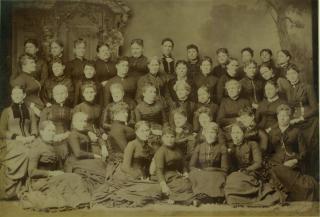Advertisement
In 1865, no tumbleweeds rolled through Portland, Oregon. Instead, rain-soaked, muddy streets signaled the town’s nascent, frontier status. More than 5,000 Portland inhabitants lived on the frontier, where saloons, gambling, and lawlessness loomed large. Perhaps such goings-on created fertile ground for piety, as Portland also boasted “more than the usual proportion of Christian people” for a frontier town, according to Earl Morse Wilbur’s History of the First Unitarian Church of Portland, Oregon, 1867–1892, published in 1893.
Christians attended young Portland’s five Protestant churches and one Catholic church. A dispersed group of Unitarians also attended the “orthodox” Christian churches (today’s mainline Protestant denominations), since there was no Unitarian church. In fact, many didn’t realize there were other Unitarians in town.
During this period, Unitarianism was not a creedless denomination; rather, along with Universalism, it represented the liberal vanguard of Protestant Christianity. Unitarians saw Jesus as a powerful role model but rejected his divinity. At the time, the Christian orthodoxy “really resented Unitarians for calling themselves Christian,” says First Unitarian Church of Portland member Cindy Cumfer, author of Toward the Beloved Community: The First Unitarian Church of Portland, Oregon, 1865–2015. “It was a battle about what different sects meant by ‘Christian.’”
In Portland, the battle intensified in 1865 when the Congregational minister used several Sunday sermons to launch “a violent attack upon the Unitarian faith,” Wilbur writes. In the pews were Mary E. Frazar and Sarah J. Burrage. Though the friends had longed for a Unitarian home of their own—in fact, Frazar and her husband offered Unitarian services at their farm—it took this flare-up of anti-Unitarianism to rouse them to action.
“They were mad as hell,” says Cynthia Grant Tucker, professor emerita of English at the University of Memphis and the author of several UU history books, including Prophetic Sisterhood: Liberal Women Ministers of the Frontier, 1880–1930. “They were worshipping at other denominations, and they were being insulted,” she says. “Those women were not going to be referred to as heretics.”
In December of 1865, Frazar, Burrage, and five other women founded the Ladies’ Sewing Society to raise funds to establish a Unitarian church in Portland. In their first year, their weekly sewing sessions earned $400. They also organized events, becoming “the center of organized life among the liberal Christians” in Portland, Wilbur writes. By late 1867, Portland’s Unitarians had bought land and built a chapel largely funded by the sewing proceeds, and called their first minister.
“People talk about the Ladies’ Sewing Society, and it’s really got an aura,” says Cumfer. Though focused, organized, and aspirational, the Ladies’ Sewing Society was not a revolutionary band of early feminists. Rather, its members acted in line with the day’s expectations of women’s “role as moral authorities” in the family, says Cumfer, following the gradual expansion of that role into the public sphere.
From the beginning, community service took center stage, as the Ladies’ Sewing Society supported the poor and reached out to Portland’s other vulnerable groups, with a watchful eye on women and children. This brand of service mirrored the era’s Anglo-Saxon ideology of creating a “purer” society, as defined by financially privileged whites. Nonetheless, a lasting tone was established: community outreach is still one of the group’s—and the church’s—core values.
The Ladies’ Sewing Society’s particular blend of financial support and humanitarianism has evolved with the times. In 1902, the group’s fundraising saved First Church from financial ruin, while women’s suffrage divided members. Decades later, Oregon feminist movement founder and UU Women’s Federation representative Eleanor Davis was a member of the by-then-renamed Women’s Alliance. In the 1970s, First Church’s new Women’s Group and what Cumfer calls a “coterie of women” fought sexism within the church and in society at large.
Today, the Ladies’ Sewing Society lives on as the Alliance. The group’s original ideals, “fellowship, lifelong learning, spiritual growth, and service . . . [are] the core principles of who we are today,” says Alliance Co-President Liz Scully. The group raises several thousand dollars each year with its annual Greens Sale, a wintertime sale of greens such as wreaths. The proceeds go to Portland-area nonprofits and “to meet unmet needs in the church,” says Scully. Moreover, the Alliance provides support and community for its own members, says Co-President Barbara Morrison.
One hundred and fifty years after the Ladies’ Sewing Society brought “liberal Christianity to this rough-and-tumble frontier town,” First Unitarian Church of Portland’s senior minister the Rev. Bill Sinkford says the group’s history offers UUs two key messages. First: “We come from good stock where women’s contributions were valued,” he says. And second: that the denomination would do well to remember its roots in liberal Christianity, and to embrace that heritage the way the Unitarians of 1860s Portland did. “It’s important to remember that [Christianity] is part of our DNA, too . . . to be open to discovering the wisdom that’s part of that tradition as well.”
